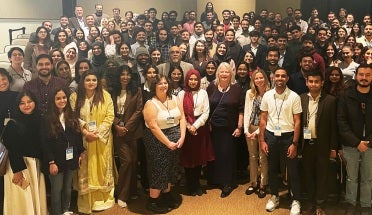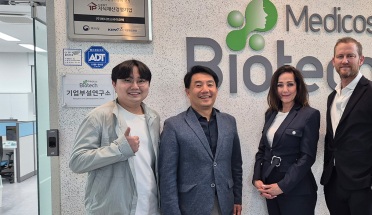
Rowing, Robotics and Rebuilding: Q&A with Global Longhorn Alumnus Erwin Muller
- Jan 13, 2022
- Global Alumni Relations
- by Fiona Mazurenko
Longhorn alumni span the globe and make a difference in their communities, and Erwin Muller (M.S. ’84) is no exception. His career helped him travel to more than 75 countries, working in more than 60 of those, including 15 across Latin America. He gained most of his professional experience in Argentina, Venezuela, Cuba, and Mexico, and now splits his time between homes in Idaho and outside Puerto Vallarta.
Originally born in Mexico of German ancestry, Muller worked 28 years for Schlumberger Oilfield Services, rising in the ranks from field engineer through operations and technical management, marketing, human resources, mergers and acquisitions, project support and business development. He retired as vice president of operations for Mexico, Central America and the Caribbean.
In addition to personal pursuits involving model railroads, classic cars, genealogy, human geography, outdoor adventures, scuba diving and, of course, rowing, Muller maintains his expertise and passion for recruiting and training students for global careers. He recently offered his advice and experience during the 2021 Global Professional Training Latin America alumni panel to an audience of students from 14 colleges and schools.
A devoted Longhorn, Muller has many family members who also attended UT Austin. We asked him about his student experiences, career, and continuing engagement with the Longhorn community—and why The University of Texas and Austin are special.
What do you consider to be your greatest accomplishments?
Having formed a close family of four, with two sons who have great human values. Being able to retire in my early 50s after living, working and traveling to over 75 countries around the world. Being able to continue leading, managing or supporting good causes and nonprofit organizations and initiatives.
What inspires you?
My belief that there are good people everywhere. Even though there are some shady characters, there is generally more good than bad. Always thinking that there are no real problems, only opportunities to solve issues. I don’t see a glass that is half full or half empty, only that the glass is too big.
What are the greatest challenges you have faced in your career, and how have you overcome them?
Even though it sounds exciting to work in different countries with different cultures and languages, it was not always easy to adjust, especially when you have a family with you. I was able to adjust and have a healthy work-life balance by planning ahead and setting clear objectives. Agreeing on considerations with employers and family was extremely important to [my ability] to achieve work and life goals.
What opportunities did you have at UT Austin that helped you get to where you are today?
I had saved money working through college, but a huge devaluation of the Mexican peso and currency control in the country left me with just enough savings to finish only one semester of graduate school. Thanks to the International House and a very helpful Good Neighbor Scholarship, I was able to complete my program. My professor, Dr. Baxter F. Womack, made sure that I finished my master’s degree in under two years, which was what I could afford.
Since I needed money, I signed up to be an intramural official, ending up as a baseball and softball umpire, soccer and basketball referee, and whatever else the program needed. I also joined the Austin Rowing Club, and eventually formed the original UT Austin rowing club. We represented the burnt orange at the inaugural Tulsa Mayor’s Cup Regatta at Tulsa Town Lake. As a side note, Neil deGrasse Tyson was our #8 seat and captain!
How are you currently involved in service or giving back in your community?
I do spend quite a lot of time ... working with a dedicated group of people, the board of directors of a nonprofit clinic in western Mexico. It serves as the primary health care facility for a large community. I bring process management knowledge to streamline operations and ensure the project's sustainability.
In 2015, when Hurricane Patricia touched land right where we live in Mexico, surrounding villages lost over 40 percent of their roofs. Hardly anybody went to the designated safe shelters, which were deemed inadequate. Luckily, there were no fatalities.
Afterward, with the Careyes Foundation, we created the Hurricane Patricia Fund to ensure that in future events, there would be proper shelters in all towns in the surrounding community. I devised a shelter program for all the schools in the community, building storm shutters for classroom doors and windows to ensure that people in town would have a safe place to take shelter. Cots, blankets, emergency supplies, tools and a power generator are available in case of an emergency.
Currently, I am heading and sponsoring a robotics club for the community. We aim to foster other programs, which might include internships, mentoring and coaching sessions, and long-term employment opportunities.
Is there a particular memory that stands out about your time on the Forty Acres?
Getting together with other Latin American students on Tuesdays at the Student Union was fun. Our co-ed intramural softball team comes to mind. And rowing early in the morning or late in the evening on Town Lake was beautiful.
But if I had to choose one, it would be the Longhorn football home game during my only season in Austin, when we lost the national championship due to a fumbled punt during the last quarter at the Cotton Bowl. It would have been a perfect season.
Many of your family members also attended UT Austin. What makes the university special?
Ten of my family members have attended UT Austin: First were my brothers, who studied aerospace engineering and mechanical engineering. My cousins majored in biology and mechanical engineering. My sister's kids studied business, communications and finance. And our sons studied computer science and neuroscience, the latter finishing his Ph.D. in December 2021.
Why did we all choose UT Austin? In my case, one of my favorite professors at the university in Mexico had a Ph.D. in electrical engineering from UT Austin, and he strongly recommended the program. Also, it had the most affordable program I had applied to.
Our youngest son was accepted to a number of universities. He decided to go [to UT] because he’d found out through social media that UT Austin had the highest percentage of graduates who would choose being a Longhorn again, if they had a choice—more than 90 percent, compared to less than 60 percent in other schools he was considering.
What does being a Longhorn mean to you?
The pride of being a member of a distinguished and special family. I own more articles of clothing with burnt orange or the Longhorn logo than any other. My wife, not a UT Austin graduate but a Texas Exes life member, is always surprised to see how many kids wear burnt orange on any given day on the Forty Acres—and it doesn't need to be a game day.
How do you like to give back to UT Austin?
I believe money is important, but investing time has a better return on investment for all. I have always said that money by itself is not worth much unless somebody does something with it. Since I am retired now and supposedly have the time, I spend a lot on personal projects, and I always try to think how I can involve UT Austin in them.
What advice do you have for current and future UT students?
Enjoy your time at UT. It goes by too fast.



